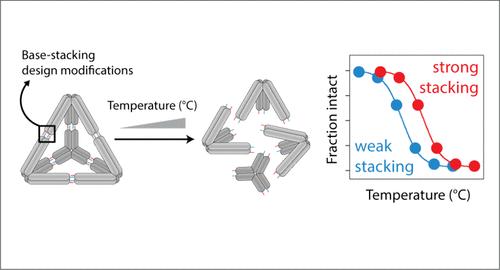碱基堆叠相互作用对DNA四面体稳定性的调节
IF 9.1
1区 材料科学
Q1 CHEMISTRY, MULTIDISCIPLINARY
引用次数: 0
摘要
DNA纳米技术使用可编程的DNA组装来制造纳米级物体。我们实验室最近的工作表明,相邻链之间的终端堆叠相互作用可能是DNA纳米技术的一个设计参数。在这里,我们通过创建具有具有相同碱基配对相互作用但不同堆叠相互作用的粘性末端的DNA四面体来探索这一想法。测试了所有16种堆叠组合,我们发现DNA四面体的熔化温度在改变设计中的单个基堆时变化高达10°C。我们还发现,弱堆叠的4bp粘端不能形成稳定的四面体,而加强堆叠可以在46.8±1.2°C的熔融温度下获得高稳定性,与弱堆叠的6bp粘端(49.7±2.9°C)相当。该结果可能适用于其他DNA纳米结构,并表明堆叠相互作用在DNA纳米结构的形成和稳定性中起作用。本文章由计算机程序翻译,如有差异,请以英文原文为准。

Tuning the Stability of DNA Tetrahedra with Base Stacking Interactions
DNA nanotechnology uses the programmable assembly of DNA to create nanoscale objects. Recent work from our laboratory suggested that terminal stacking interactions between adjacent strands could be a design parameter for DNA nanotechnology. Here, we explore that idea by creating DNA tetrahedra with sticky ends containing identical base pairing interactions but different stacking interactions. Testing all 16 stacking combinations, we found that the melting temperature of DNA tetrahedra varied by up to 10 °C from altering a single base stack in the design. We also show that a 4 bp sticky end with weak stacking does not form stable tetrahedra, while strengthening the stacks confers high stability with a 46.8 ± 1.2 °C melting temperature, comparable to that of a 6 bp sticky end with weak stacking (49.7 ± 2.9 °C). The results likely apply to other DNA nanostructures and suggest that stacking interactions play a role in the formation and stability of DNA nanostructures.
求助全文
通过发布文献求助,成功后即可免费获取论文全文。
去求助
来源期刊

Nano Letters
工程技术-材料科学:综合
CiteScore
16.80
自引率
2.80%
发文量
1182
审稿时长
1.4 months
期刊介绍:
Nano Letters serves as a dynamic platform for promptly disseminating original results in fundamental, applied, and emerging research across all facets of nanoscience and nanotechnology. A pivotal criterion for inclusion within Nano Letters is the convergence of at least two different areas or disciplines, ensuring a rich interdisciplinary scope. The journal is dedicated to fostering exploration in diverse areas, including:
- Experimental and theoretical findings on physical, chemical, and biological phenomena at the nanoscale
- Synthesis, characterization, and processing of organic, inorganic, polymer, and hybrid nanomaterials through physical, chemical, and biological methodologies
- Modeling and simulation of synthetic, assembly, and interaction processes
- Realization of integrated nanostructures and nano-engineered devices exhibiting advanced performance
- Applications of nanoscale materials in living and environmental systems
Nano Letters is committed to advancing and showcasing groundbreaking research that intersects various domains, fostering innovation and collaboration in the ever-evolving field of nanoscience and nanotechnology.
 求助内容:
求助内容: 应助结果提醒方式:
应助结果提醒方式:


